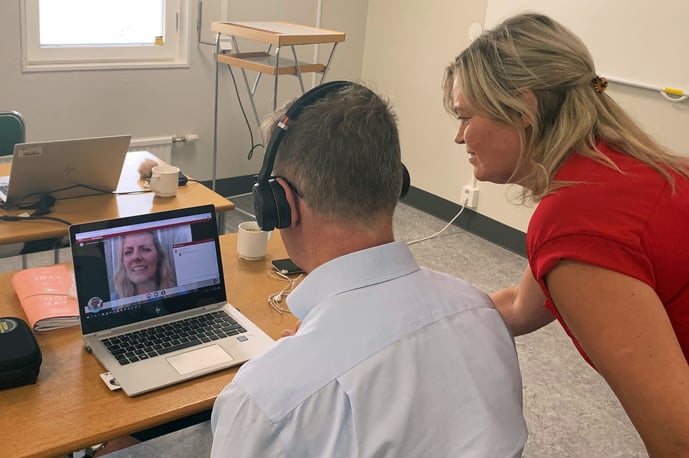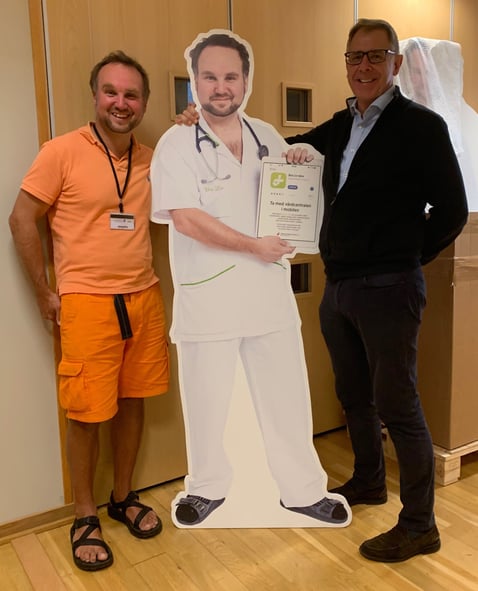What comes to mind when you think of healthcare in Sweden? You’re probably thinking of a sterling healthcare system with an abundance of resources and smooth processes, a forward-thinking ensemble that fosters innovation and puts the patient first. Dr Martin Godfrey visited two primary care clinics in Sweden to find out if that is indeed the case and, if so, how does the UK compare. (Hint: it isn’t and not far!)
Dr Martin Godfrey is a GP and Clinical Network Lead at Lambeth CCG. Martin’s diverse experience includes publishing, medical education, public relations, and profound interest in technology and digitalisation; he is an effervescent spirit with a relentless yearning for knowledge and optimisation. We followed Martin during his visit at two vårdcentraler mottagningar, i.e. primary care clinics: Närhälsan Online in Västra Götaland, Sweden’s largest county, and Bra Liv nära, Jönköping, the early adopter in Swedish healthcare. The questions in mind were “how and why has healthcare in Sweden succeeded?” and “what are the similarities and differences with the NHS?”– two challenging investigations, as questions like this are usually accompanied by preconceptions. This was an exemplary case of how they can be shattered; as you will see, Sweden and the UK are not that different.
1) Medical state of the population
First things first: the axis of healthcare are the patients. As Dr Godfrey summarised, the clinical picture of the two countries is identical. The population in Sweden and the UK face the same medical issues: an alarmingly ageing population, lifestyle-related conditions, cancer, cardiovascular diseases, and comorbidity. The main challenge deriving from all these conditions is the pressure on the healthcare system. All of them require frequent visits and constant monitoring, resulting in great demand for resources: a lot of the medical professionals’ time and the healthcare system’s expenses.
On the bright side, there is a common way to battle (or at least minimise) the impact of most of these medical issues and that is preventative care. It is then no wonder, that both countries have been placing great focus on prevention during the last years, highlighting action plans, like the Long Term Plan, that make patients independent and rethinking the medical consultation itself.
There are many more similarities than differences. In terms of the clinical, the two systems are identical
2) Structure and finances
Healthcare structure and funding are unique to almost every country. That is particularly true for the NHS for two reasons: a) The NHS is a mature organisation with a long and proud history, and b) the NHS lays a lot of attention and periodically adjusts its structure. Since not a lot is known about Sweden’s healthcare structure – hence there is little preconception, this was one of the main points of interest for Dr Godfrey. The outcome? No healthcare system is exactly like the NHS, but on a not-so-abstract level, Swedish and British healthcare have a similar structure and funding flow, with Sweden having a shorter but wider structure tree.
In Sweden, both primary and secondary care are under the management of a län or county, which determines the allocation of resources and service planning. Patients have a free choice of registration in any primary care clinic of their county and each primary care clinic is funded per registered patient. After referral, the patient should be able to see a specialist within 90 days (appr. 12 weeks) and if necessary, have an operation scheduled within an additional 90 days. Healthcare in Sweden is publicly funded and covers approximately 12% of the GDP. A consultation slot may vary in length (the slot is 20 minutes long for our two case studies) and charged 100 SEK (£8.5) to the patient, with a maximum annual charge of 1,100 SEK (£92.5) per patient.
In the UK, primary care is funded by both NHS England and each centre’s respective CCG, for locally commissioned services and integration with other healthcare services. When a GP practice joins the newly introduced Primary Care Networks, it receives extra funding. Each consultation slot with a GP is 10 minutes long, individually funded, and free for the patient. After referral, the patient should receive treatment within 18 weeks. Healthcare in the UK is, of course, free and covers approximately 10% of the GDP.
In the UK, I think the system is a bit more regimented. (…) 4 patients an hour would be a dream for a British GP
3) Towards integrated healthcare
A surprising finding from Dr Martin Godfrey’s discussion with the Swedish healthcare professionals in Jönköping and Västra Götaland was the common direction to integrated healthcare. Both countries have a planned, nation-wide directive to bring together, among others, medical care, mental health and social services with three main goals: a) improve population health – the elderly and the chronically ill in particular, b) provide more financial and operational freedom to the units, and c) increase efficiency and minimise silos.
In both countries, integrated care will be outlined around the patient’s specific condition, involving all professionals necessary, to provide an optimal solution and improve the patient’s life to the absolute possible extent. In Sweden, a Samordnad Individuell Plan or SIP (Coordinated Individual Plan) can be requested by the patient and can involve representatives from institutions of social welfare or even private services. In England, Integrated Care Systems (ICS), involving healthcare providers, commissioners and local authorities, have already started rolling out and more than a third of the country’s population is now covered by one. Frimley, which is part of an ICS, is already reporting a reduction in GP referrals [1].
4) Private players online
Out-of-system online consultations were a large part of the discussion between Dr Godfrey and Dr Ulf Österstad, District Physician and Head of Operations at Bra Liv Nära, in Jönköping. Sweden and the UK seem to live parallel lives when it comes to online medical consultations provided by private parties. The good news for the UK is that, while private players are still on the rise in Britain, Sweden has seen that play.
Each patient is registered in his/her county of residence, however, when seeking private online consultations, the patient’s county has to reimburse the county in which the online private clinic is registered; consequently, that county would pay the private player. As private players caught up, the counties, the main funding distributors of healthcare, ended up paying through the nose for private online consultations. The issue became such a topic in Sweden, that the entire cost for out-of-county reimbursements had to be cut down over and over – for the public sector too. The Swedish government realised that online access to healthcare is a public demand and, if public healthcare wouldn’t provide it, it would be an enormous cost. Therefore, public healthcare providers received a top-down message: “Make online consultations available”. It’s been a couple of years since, and public healthcare is catching up and gaining ground in providing care online.
In the UK, the situation is still unfolding, particularly in London, but it doesn’t seem to be cooling down anytime soon. While the financial cost for the public healthcare is just as impactful, the consequences for British patients are much more visible: Currently, when patients in the UK use such a service, they get automatically registered to them. Naturally, they are not registered with their chosen NHS surgery anymore. Moreover, data shows that the fittest patients are more inclined to use that service, resulting in an additional cost for the GP clinics [2], as funding is distributed on a capitation basis. Private online consultations are expanding in the UK and the way for public healthcare to battle that is to make online consultations available. The Long Term Plan is highlighting the same top-down initiative, but, in accordance with Dr Godfrey’s visit, there are a few pointers from Sweden for more proactive upheaval in digital health.
5) Attitudes towards digitalisation
When asked about what surprised him the most from his two-day visit, Martin recited the story of Charlotte Lundholm, Development Leader and Deputy Manager, and Dr Gudrun Greim, Business Manager and Medical Advisor at Närhälsan. During that meeting, Charlotte and Gudrun described the attitudes during the process of digital transformation and noted strong backlash, resistance, and a negativistic attitude during the unveiling of the plan. They mentioned that some medical professionals felt threatened by the new technology and the top-down initiative. At this point, the painting of Swedish healthcare, with the digital-first approach to innovation, the early adopter attitude and the consensus culture was tainted.
This narrative did not seem far from what Martin described as the current attitude on online consultations among GPs in the UK. Presently, GPs are extremely pressed with short consultation times, spanning from physical visits to follow-ups and appointments over the phone. Introducing online consultations to that equation feels more than an addition in an already packed schedule, which makes them hesitant to get on board motivation-wise. However, as both Ulf and Gudrun noted during the visit, online consultations turned out to be a relief and a highly desired state for their medical professionals, a complementary tool to physical consultations rather than an extra burden, and a cause for celebration for the patients. To exemplify, Närhälsan Online started with 200 online consultations and 10 doctors a month and is now conducting 500 online consultations a week; Healthcare professionals in Närhälsan Online feel that they have ownership of their work, Charlotte reported. Martin commented:
Sweden faced the same challenges as the UK will face. There was a lot of scepticism from the doctors, and the doctors are the main impediment to this. What I find reassuring is that there was an excessive reaction to online consultations, and I can see that acknowledging it and managing expectations can halt defeatist attitudes
The initial goal of the visit may have been to learn from the digitalisation of healthcare in Sweden. However, the starting point and the way to success turned out to be the greatest lessons Sweden had to offer. Healthcare in Sweden was trying to tackle the same pressing issues as the NHS and the Long Term Plan are currently aspiring to solve. The road was rocky throughout the way, and the people tasked with carrying the projects out felt like driving in fog – but they made their way to the light at the end of the tunnel and carved their own best practices along the way.
Our conversation with Dr Martin Godfrey did not stop at scoping the state of affairs of healthcare in Sweden and the UK. Our next topic was how the UK and the NHS can use these similarities and experience and apply them to their own digital transformation journey and implementation of online consultations: Do you want to read our 7 steps a successful implementation of your virtual clinic?




